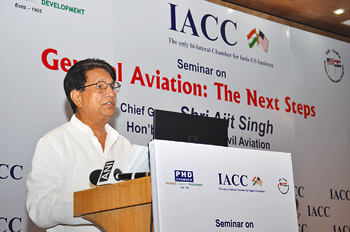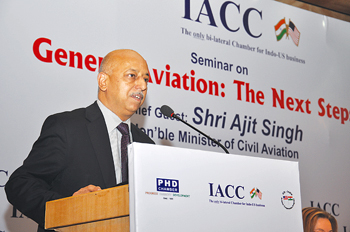General Aviation: The Next Step
A day-long seminar was organised by Indo-American Chamber of Commerce (IACC) in collaboration with US-India Aviation Cooperation Programme (ACP) on efforts to boost general aviation in India.


A glimmer of hope emerged at the seminar on "General Aviation: The Next Steps", organised by the Indo-American Chamber of Commerce (IACC) in cooperation with the US-India Aviation Cooperation Programme (ACP), as the Minister of Civil Aviation Ajit Singh, spoke about policy changes to be made and a time frame to ease out regulatory issues.
Delivering the inaugural address, Singh said that the political consensus allowing 49 per cent investment in Indian carriers shows the commitment of his government. He spoke about different steps taken by the government which would help in the growth of civil aviation sector in the country including the state-of-the-art facilities coming up at several airports in the country, 15 new Greenfield airports, provisions in the Union Budget 2013-2014, etc.
Singh said that bilateral relations between India and the US have strengthened over the years and the "open sky policy" has helped India's aviation market grow. He said that the current estimates indicate that Indian airports would require an investment of about Rs 67,000 crore ( 670 billion) during the next five years, of which 75 per cent is likely to come from the private sector.
He stated that India has the potential to become a maintenance, repair and overhaul (MRO) hub and airlines can create subsidiaries for ground handling. However, he said that airlines should form consortiums for the purpose as the government will put a cap on the number of ground handlers. To facilitate the growth of MRO business, the government he said has recently decided to give several concessions which include extension of time period allowed for utilisation of aircraft parts, etc.
In order to cater to the need for trained and skilled manpower in the country, he said the government is keen on setting up an Aviation University and said that suggestions from IACC would be welcome.
The Minister ended with a positive note, quoting former US President John F. Kennedy, "Things do not happen, things are made to happen."
K. Narayan Rao, Director, GMR Infrastructure Ltd and Chairman, Civil Aviation Committee, PHDCCI, spoke about the challenges faced by general aviation in India, and was followed by Todd Hathaway, Country Director, Beechcraft, who gave the US industry perspective and suggested that it is highly relevant to provide and encourage innovation in all fields of civil aviation sector. On the Indian industry perspective, Raman Kapoor, Associate Vice President, Business Development, Ligare Voyages, said that the sector is growing and gave out details of what can still be done.
The need for setting up a Working Group to look at the aviation requirements was emphasised upon by C.J. Collins, Senior Representative, Federal Aviation Administration (FAA). She said representatives of the Civil Aviation Ministry, the Directorate General of Civil Aviation (DGCA), industry partners, etc should be members of the Working Group. Judy Reinke, Minister Counselor for Commercial Affairs, US Embassy said that India is the least penetrated but has huge potential.
Giving out the keynote address, Arun Mishra, Director General, Directorate General of Civil Aviation, said that there is primary synergy between India and the US. "We are new kids in the block and need support." "Safety is my primary concern. Regulation of safety in business aviation is very important." He admitted that there is shortage of staff at DGCA but said that the process for filling the vacancies has begun. There are several issues which the DGCA is looking at, he said, including trying for short notice flights, issues of general aviation flying into defence control outfit, etc. "There is a long way to go and we want to engage with the FAA in a very constructive manner."
The inaugural session ended with Dr Vivek Lal, the Chairman Aviation and Aerospace Committee and President and CEO, New Venture, Reliance Industries Limited (RIL), stating that the conference can act as a catalyst in formulating policies on general aviation and there is tremendous opportunity for the US and India to work together.
Technical Session I
The first technical session was on "Policy and Regulatory Framework" and was presided over by Atul Sharma, former Regional President, IACC and Managing Partner, Link Legal. Emphasising on the need for safety, A.M. Ganapthy, Head, Standards Committee, Business Aircraft Operators Association (BAOA), spoke about the need for international standards for India and advantages of International Standard for Business Aircraft Operations safety management system (IS-BAO-SMS), which is regarded as a golden standard for safety. Sudipta Dutta, Director, Directorate of Air Worthiness, DGCA, spoke on management of airworthiness and concerns of general aviation operators which includes lack of budgetary support, non-availability of qualified manpower, proper training to working personnel, proper quality audit system and a dedicated auditor, adequate management support for improvement, etc.
Ravi Nath of Rajinder Narain and Co. Solicitors and Advocates, spoke on the legal aspects of finance and leasing of aircraft. Enforcement of foreign decrees, arbitral award enforcement, deregistration issue, etc were among different legal aspects he highlighted on. Similarly, Kamal Abrol, Partner, PricewaterhouseCoopers (PwC), threw light on taxability under domestic tax provisions, dry lease and wet lease, indirect taxes on leasing of aircraft, dual taxation, etc.
Technical Session II
The luncheon session was on "General Aviation: Technology and Infrastructure" and was presided by Captain Rohit Kapur, President, Business Aircraft Operator's Association (BAOA). Ravi Menon, Executive Director, Air Works, detailed out on "MROs for General Aviation" and said that there is need for attitudinal changes, optimising the capabilities available in the country, and aligning regulations with the needs of the industry. He welcomed the government's move to set up an aviation university to develop manpower and reduction in taxation and royalty on MRO components. "Airports and Airspace Restructuring" was the subject, Arjun Singh, former Programme Director, US-India ACP, spoke about in detail.
Wing Commander (Retd) B.S. Singh Deo, Managing Director, Bell Helicopter India, spoke on "Heliport Management and Regulatory Challenges in General Aviation". Helicopter is the vehicle of the future and can be used in 30 different roles, he said, but informed that the helicopter fleet has reduced in 2012 and would reduce further. "It is like a dream not come true." Talking on the impediments, he said that noise pollution was the primary reason which came on the way of a helicopter service which was planned to be started by Pawan Hans between South and North Mumbai. However, he said that today new technologies have come up and helicopters are now equipped with noise abatement designs. However, later at the same session R.P. Sahi, Consultant, Ministry of Civil Aviation and former Joint DG, DGCA, informed that the heliport at Mumbai could not be developed as the land identified was under the Coastal Regime Zone and clearances could not be attained.
At the end of session, while the members agreed that MROs need to come out of international airports, the need to develop other areas other than metros for the purpose was also felt. "The growth story of business aviation will move together with the growth story of the nation."
Technical Session III
The session on "Role of General Aviation Industry in Key Areas" was chaired by R.P. Sahi, Consultant, Ministry of Civil Aviation and former Joint DG, DGCA. Panellist Lex Den Herder, Vice President, Government and Industry Affairs, Universal Weather and Aviation Inc. spoke on "The Value of Business Aviation, Implementing Change and Views for New Opportunities". He said that BAOA is the voice of business aviation in India and urged more and more members to join the association. He said that the advanced passenger information system (APIS) is currently utilised only for airline operations. Sanjeev Choudhury, Senior Vice President (Business Development), Arrow Aircraft and Ex-Senior Vice President, Indocopters Pvt Ltd, gave a presentation on "Helicopter Emergency Medical Service (HEMS) and other Emerging Areas of Operations". He expressed regret that in India till date there were no dedicated HEMS service and what is there, is medical evacuation, wherein passenger aircraft are used for flying a patient from one destination to the other. "Fortunately, one aviation company is now starting the HEMS with seven helicopters." Choudhury also spoke about powerline operations.
The mood at the day-long which was a mix of hope and despair, witnessed a sudden uplift as Ammeet K. Agarwal, President and CEO, Supreme Aviation, gave his presentation. Comparing India with the US, Canada, South Africa, he said that 900 new airstrips can be developed in India, which will lead to five lakh job opportunities and 640 districts of India will be connected with each other. "It takes only 4 lakh, six weeks of training and a medical test to get a private pilot license in the US. And with the license, you can fly from anywhere and anytime. His calculations said it is possible to have a two and fro journey from Delhi to Jaipur is just a few hours and for 2,000 per person in a private charter. While several eye brows were raised, Agarwal with his futuristic statements and amusing figures (which he said is a trade secret) made the session lively.
The Last Session
The last session on "Emerging Areas and opportunities in General Aviation" was once again presided by Rohit Kapur and Rajan Mehra, Managing Director, Universal Weather and Aviation-India, Ed Smith, Senior Vice President-International and environmental Affairs, General Aviation Manufacturers Association (GAMA) and Manish Mishra, Khaitan and Co were the panellists. Trying to boost the mood of one and all as doubts were raised in the previous session whether India would actually be able to achieve the figures in the next 5-10 years, Mehra said that things can change suddenly and dramatically. "A couple of years back, China had lesser aircraft than India, but now there is a quick turnaround." There are problems but if government realises and acts, everything is possible. He said that there is now positivity as far as the government is concerned and the budget 2013-2014 has minor concessions too. "Could visualise things happening very fast," he said. While Smith spoke on the economic value of a strong general aviation industry and Mishra threw light on the legal aspects.
SP's Aviation and SP's AirBuz were media partners of the event.





